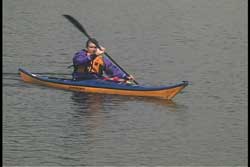
Stern High Brace Turn
By Wayne Horodowich
There are many different ways to turn your kayak when it is moving. If you do not want to lose momentum you can introduce a forward sweep stroke into your normal forward stroke sequence to give you more turning power. If you need to slow down and maneuver at the same time, you can choose to do a breaking turn such as the stern high brace turn or the low brace turn. See USK article, "Low Brace Moving Turn." I like to use the stern high brace turn when my kayak is moving quickly and I need to quickly maneuver between kayaks during clinics or in rock gardens when I am playing. I also use the stern high brace turn when I surf waves. As you will see at the end of the article, the stern high brace turn lends itself nicely to moving directly into a forward stroke if it is needed.

As with any breaking (decelerating) turns you need to be moving for it to work. You will find that the faster your kayak is moving the more support you can get from your paddle when you perform your turn. Since it is a brace turn, support is an essential part of the skill.
Of course, having a strong forward stoke will provide you with plenty of momentum. Since this technique can also be used in surf, your momentum may be generated by the wave you are riding. In either case, since this is a breaking turn we are assuming you are moving with some speed. If you were moving slowly you will probably not going to use this skill as an option.
If you are providing your own momentum and you are planning in advance to use this technique, you can set up for the turn by taking your last forward stroke on the opposite side of the kayak to initiate the turn. Use a sweep stroke to get the most turn for the set up. The farther out you sweep the more turn initiation you get.
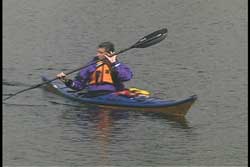
Once I have finished my initiation stroke on the opposite side, I move into a high brace position. I also begin to turn my body so I am keeping the paddle in the front plane of my body. It it important, for many reasons, to rotate your body. Shoulder safety is the most important reason. If you face forward and just reach the paddle behind your body you run the risk of shoulder strains.
The second reason to rotate your body is it allows you to begin edging your kayak when your outside knee/thigh hooks under the thigh brace when you rotate your torso. When you hook your knee/thigh under the thigh brace and rotate, your kayak automatically begins to edge. See future USK article, "Leaning vs Edging." The reason you want to edge your kayak is the greater turning ability you get from a kayak when it is on edge.
The third reason you want to rotate is to get look at your blade before you place it on the water. Since this is going to be a high bracing turn, you want to be sure that your blade is in the high brace position with the power face facing the water and your arms are in a secure high brace position to minimize any potential shoulder injuries. See USK articles, "Shoulder Safety" and "High Brace And Low Brace Blade Mechanics."
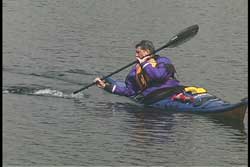
Once I see I have my blade ready for a high brace, I know I can feel comfortable to begin to lean out over the water without concern of capsizing, because the high brace will provide the support to keep me upright. How much you lean and how much support you will get from your paddle moving over the water, can only be learned from experience. Sooner or later you will lean too much for the support you are getting and you will probably capsize. Please do not get discouraged, because this is part of the learning curve.
If you do capsize, use this opportunity as a learning moment. You will see if your immersion clothing is appropriate for the conditions and you will have a chance to practice your capsize recovery techniques, which should be practiced on a regular basis.
As you will find, the faster your kayak is moving the more support you will get. Your blade is planing on top of the water. You are holding your blade in a fixed position with respect to your body, but the blade is only moving with respect to the water because the kayak is moving. That planing action is providing you support so you can lean on the paddle.
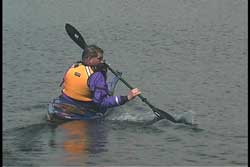
The original placement of the paddle is behind you. As you rotate your body you place the paddle in the water with a forty-five degree angle between the kayak and the paddle shaft. The angle of the blade is flat on the water. If your blade placement is too close to the kayak (less than a forty-five degree shaft angle) you will not get as much support.
If the paddle shaft angle is too much when means you are reaching to far to your side, rather than back, you will slow too quickly and not get the desired results. Reaching too far to the side also puts you in a possible capsize position if your blade angle is incorrect when it hits the water. If you put your paddle ninety degrees out to the side and your leading blade edge were too low you could dive your blade while your kayak is on the move. It will be a quick capsize.
The forty-five degree shaft angle placement is the best of all worlds with respect to support and low rick of capsize as long as your blade is placed flat and you lean appropriately. When I place my blade, you can see I am looking right down the paddle shaft as the blade hits the water.
The reason I lean out over the water is to get more edging out of my kayak. The more I edge the greater turn potential I can get. Since kayaks are made to turn more quickly and efficiently when edged, it is advantageous to use these design features.
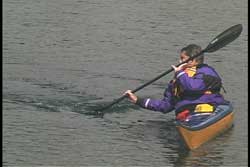
Since this is a decelerating turn, I will be slowing down as my paddle drags in the water. This is part of the reason you chose this technique. You decided you need to slow down and turn at the same time. I often use this technique to get to a capsized student's bow. I plan my approach so my kayak stops at the bow and have my kayak turned into position for a T-Recovery. See USK article, "T-Recovery." I can adjust my deceleration by how much I lean on my paddle. The more I lean the more drag and the more quickly I stop.
Keep in mind that the slower you kayak moves the less support you get from your paddle. Therefore, as you slow down your brace is becoming less supportive. You now have some choices to make. You can start moving more of you body weight back over your kayak (less leaning) or you can begin moving your paddle by rotating your body forward to provide more support from the blade. As you rotate your body forward, while staying in the high brace position, your blade will be moving over the water as if you were performing a part of a sculling brace. See USK article, "Sculling." Since you can only move your paddle so far, sooner or later you need to get your body weight back over your kayak because your support will disappear.
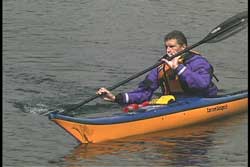
I like to use a combination of moving my paddle and bringing myself back over the kayak. In fact, I use my moving of the paddle (that half forward scull) as my way of bringing my body back over my boat. I know I have to move my paddle as I feel my blade beginning to sink as the kayak slows. From experience, I know where my capsize point is and when I feel I am approaching that point a little voice in my head begins to say, "Danger Will Robinson, Danger." I also call it an "Uh Oh" moment. See USK article, "Uh Oh Moments In Kayaking." When this occurs I know I need to begin sweeping my stern high brace toward the bow and bring my body back over my cockpit.
I can still keep some edge on my kayak, but I need to be balanced over my kayak knowing that my paddle is no longer being used as a brace. I will only continue to edge if I still need to turn further.
By the time I have turned and sufficiently slowed or stopped, the high brace turn is complete. The stroke ends when you have moved your blade to the bow area of your kayak. Hopefully I have managed to maneuver my kayak into the position I wanted. However, there are times when one brace turn just doesn't give you what you want or you need to regain some forward momentum.
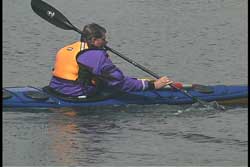
One of the reasons I like this high brace turn is the way in which it seamlessly moves into a forward stroke. When the stern high brace turn is completed, your blade is near the bow of your kayak ready to go directly into a forward stroke. Here I have just finished my high brace turn and I am ready for a powerful forward stroke. Therefore, all I have done through this entire stroke is to stay in a high brace position and rotate my body from the rear placement to the bow completion.
As I said earlier, I use this technique when I have to move between my students during a class. I will use the stern high brace turn to thread my way between kayaks and then accelerate to give myself more momentum for the next turn I need to perform.
Another reason I like this technique is because I am using body weight to quickly turn my kayak. There is not a lot of energy being used to do this quick turn. All I am doing is leaning over a brace.
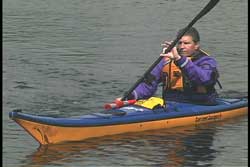
Once I complete the stern high brace turn, I am in a very proactive stable position, to paddle forward or change my paddle and body position as needed for my next maneuver. When I have used this technique in surf, it was usually done when I wanted to ride a wave and then get off of it to go out and ride another one. See USK article, "Surf A Wave And Get Off."
When I use this technique to assist a capsized boater, as I slow down near the bow I actually use my paddle, which is in a high brace position, as an extension of my hand to move the bow of the capsized kayak toward my cockpit. Since their kayak is angled toward mine, I reach over the bow with my blade to pull the bow towards me.
As you practice this technique you will see how it transitions nicely into other maneuvers. The best way to develop this skill is going out on flat water and linking multiple stern high brace turns. Once you feel confident with your strong side then try it on your off-side. When the off-side feels good, try linking successive on-side and off-side high brace turns with some strong forward strokes between them to regain the momentum needed. When you feel confident performing the stern high brace turn I believe it will work its way into your regular paddling skills.
Pictures seen above were taken from the USK Video "USK's Bracing Clinic " New video (8/2008)
Updated 2/1/2009
© Copyright USK